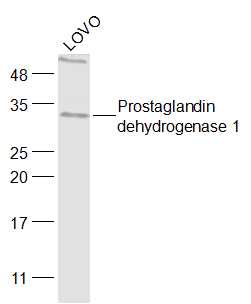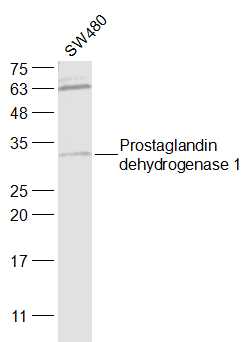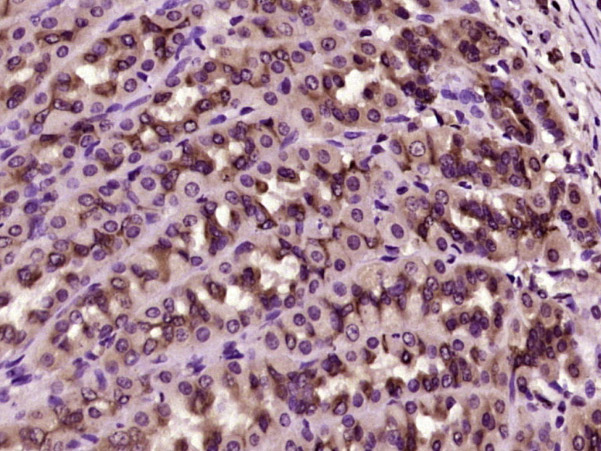
Rabbit Anti-Prostaglandin dehydrogenase 1 antibody
HPGD; Hydroxyprostaglandin dehydrogenase 15 (NAD); NAD+ dependent 15 hydroxyprostaglandin dehydrogenase; PGDH; PGDH_HUMAN; PGDH1; Prostaglandin dehydrogenase 1; SDR36C1; Short chain dehydrogenase/reductase family 36C,member 1; 15 hydroxyprostaglandin dehy
View History [Clear]
Details
Product Name Prostaglandin dehydrogenase 1 Chinese Name 前列腺素脱氢酶1抗体 Alias HPGD; Hydroxyprostaglandin dehydrogenase 15 (NAD); NAD+ dependent 15 hydroxyprostaglandin dehydrogenase; PGDH; PGDH_HUMAN; PGDH1; Prostaglandin dehydrogenase 1; SDR36C1; Short chain dehydrogenase/reductase family 36C,member 1; 15 hydroxyprostaglandin dehydrogenase [NAD+]; 15 PGDH; 15-hydroxyprostaglandin dehydrogenase [NAD+]; 15-PGDH; 15PGDH. literatures Research Area immunology Signal transduction Immunogen Species Rabbit Clonality Polyclonal React Species Human, Rat, (predicted: Mouse, Pig, Cow, Horse, Rabbit, ) Applications WB=1:500-2000 ELISA=1:5000-10000 IHC-P=1:100-500 IHC-F=1:100-500 IF=1:100-500 (Paraffin sections need antigen repair)
not yet tested in other applications.
optimal dilutions/concentrations should be determined by the end user.Theoretical molecular weight 29kDa Cellular localization cytoplasmic Form Liquid Concentration 1mg/ml immunogen KLH conjugated synthetic peptide derived from human Prostaglandin dehydrogenase 1: 55-160/266 Lsotype IgG Purification affinity purified by Protein A Buffer Solution 0.01M TBS(pH7.4) with 1% BSA, 0.03% Proclin300 and 50% Glycerol. Storage Shipped at 4℃. Store at -20 °C for one year. Avoid repeated freeze/thaw cycles. Attention This product as supplied is intended for research use only, not for use in human, therapeutic or diagnostic applications. PubMed PubMed Product Detail This gene encodes a member of the short-chain nonmetalloenzyme alcohol dehydrogenase protein family. The encoded enzyme is responsible for the metabolism of prostaglandins, which function in a variety of physiologic and cellular processes such as inflammation. Mutations in this gene result in primary autosomal recessive hypertrophic osteoarthropathy and cranioosteoarthropathy. Multiple transcript variants encoding different isoforms have been found for this gene. [provided by RefSeq, Mar 2009].
Function:
Prostaglandin inactivation. Contributes to the regulation of events that are under the control of prostaglandin levels. Catalyzes the NAD-dependent dehydrogenation of lipoxin A4 to form 15-oxo-lipoxin A4. Inhibits in vivo proliferation of colon cancer cells.
Subunit:
Homodimer.
Subcellular Location:
Cytoplasm.
Tissue Specificity:
Detected in colon epithelium (at protein level).
DISEASE:
Hypertrophic osteoarthropathy, primary, autosomal recessive, 1 (PHOAR1) [MIM:259100]: A disease characterized by digital clubbing, periostosis, acroosteolysis, painful joint enlargement, and variable features of pachydermia that include thickened facial skin and a thickened scalp. Other developmental anomalies include delayed closure of the cranial sutures and congenital heart disease. Note=The disease is caused by mutations affecting the gene represented in this entry.
Cranioosteoarthropathy (COA) [MIM:259100]: A form of osteoarthropathy characterized by swelling of the joints, digital clubbing, hyperhidrosis, delayed closure of the fontanels, periostosis, and variable patent ductus arteriosus. Pachydermia is not a prominent feature. Note=The disease is caused by mutations affecting the gene represented in this entry.
Isolated congenital nail clubbing (ICNC) [MIM:119900]: A rare genodermatosis characterized by enlargement of the nail plate and terminal segments of the fingers and toes, resulting from proliferation of the connective tissues between the nail matrix and the distal phalanx. It is usually symmetrical and bilateral (in some cases unilateral). In nail clubbing usually the distal end of the nail matrix is relatively high compared to the proximal end, while the nail plate is complete but its dimensions and diameter more or less vary in comparison to normal. There may be different fingers and toes involved to varying degrees. Some fingers or toes are spared, but the thumbs are almost always involved. Note=The disease is caused by mutations affecting the gene represented in this entry.
Similarity:
Belongs to the short-chain dehydrogenases/reductases (SDR) family.
SWISS:
P15428
Gene ID:
3248
Database links:Entrez Gene: 3248 Human
Omim: 601688 Human
SwissProt: P15428 Human
Unigene: 596913 Human
Product Picture
LOVO(Human) Cell Lysate at 30 ug
Primary: Anti-Prostaglandin dehydrogenase 1 (SL6051R) at 1/1000 dilution
Secondary: IRDye800CW Goat Anti-Rabbit IgG at 1/20000 dilution
Predicted band size: 29 kD
Observed band size: 29 kD
Sample:
SW480(Human) Cell Lysate at 30 ug
Primary: Anti-Prostaglandin dehydrogenase 1 (SL6051R) at 1/1000 dilution
Secondary: IRDye800CW Goat Anti-Rabbit IgG at 1/20000 dilution
Predicted band size: 29 kD
Observed band size: 29 kD
Paraformaldehyde-fixed, paraffin embedded (rat stomach tissue); Antigen retrieval by boiling in sodium citrate buffer (pH6.0) for 15min; Block endogenous peroxidase by 3% hydrogen peroxide for 20 minutes; Blocking buffer (normal goat serum) at 37°C for 30min; Antibody incubation with (PGDH) Polyclonal Antibody, Unconjugated (SL6051R) at 1:400 overnight at 4°C, followed by operating according to SP Kit(Rabbit) (sp-0023) instructionsand DAB staining.
References (0)
No References
Bought notes(bought amounts latest0)
No one bought this product
User Comment(Total0User Comment Num)
- No comment





 +86 571 56623320
+86 571 56623320
 +86 18668110335
+86 18668110335

